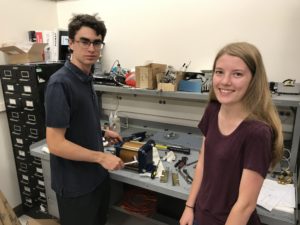The fourth week of my internship was amazing. To start the week we got our Xbee communication devices Daisy chained together. This helps increase the range of the devices, as data from the farthest Xbee can be relayed back to the receiver through the other Xbees. We have also been refining how the data is received through these devices. Originally, we had a timestamp that was added to the temperature data on the Arduino board, but this timestamp could not give the time of day because the Arduinos have no internal clocks. Once they are disconnected from power the Arduino clock restarts. To get around this issue we now have the timestamp added to the data when it reaches the program running on the computer. This is a much better as the computer has the time of day, and that information will help line up the data from our Arduinos with other data being collected by existing devices. As an introduction to data processing, we also got an introduction to Terminal. Aaron showed us the terminal commands that will be used to create a file with our data from our sensors at certain intervals. This will ensure none of our data is lost. We have also continued to test the range of the Arduino devices. We currently hypothesize that the heat may affect the range of the Xbees, but further testing is necessary to determine this. We are also still working on adding a Co2 sensor to the Arduino boards.
In the rock mechanics lab with Eric, we got experience fixing a pump that is used to compress gases. This was interesting because we got to see the pump unassembled then put back together.
We also started our Co2 bucket experiment later in the week. This experiment is very exciting because we have gotten to gain experience in each step of the process. This started with us building the bucket contraption that will be used for the experiment. During this process, we had to watch for sources of error and try to ensure that Co2 will only flow out of the top of the bucket. The experiment itself was somewhat difficult as each of the six trials lasted 8 minutes with data taken once every 5 seconds. The wind speed and temperature data had to be entered manually which was very time-consuming. We did two groups of six trials, one with one bucket and one with two buckets combined, which increased the distance of the top of the bucket from the diffuser. This modification was supposed to even the Co2 concentrations at the top of the bucket.
Outside of work I have continued to explore Salt Lake and the surrounding areas. On Sunday my Grandparents visited, and this Saturday my parents visited.



There are no comments published yet.